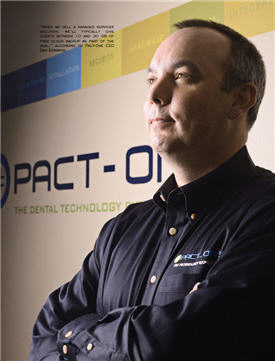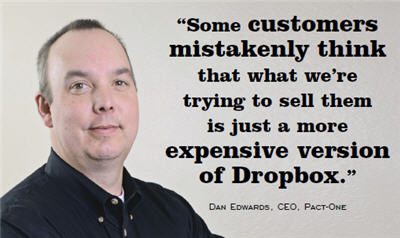3 Ways To Uncover New Cloud Sales Opportunities
By The Business Solutions Network
A renewed focus on selling managed services is helping this MSP develop more profitable customers and a second year of double-digit revenue growth.

Becoming experts in the dental market has served Pact-One very well over the years. Since its inception in 2003, the company, which describes itself as an IT management and MSP firm, has grown to more than 50 employees and nearly $8 million in annual sales revenue. After noticing a trend a couple of years ago that more and more of his IT vendors were offering their solutions as a service, Dan Edwards, CEO of Pact-One, decided that his company needed to move in that same direction. This year, Pact- One is projecting 17% sales revenue growth over last year, due largely to its renewed focus on putting break-fix clients on managed services programs. Edwards has found that clients who sign up for managed services programs are easier to engage with and upsell on followup visits.
Pact-One has been selling managed services for more than eight years, starting with remote monitoring and management (RMM) services and expanding into Antivirus (AV) as a Service, hosted exchange, and cloud backup. Over the past couple of years, Edwards and his team have learned three secrets that have led to consistent double-digit growth selling managed services.
1. Start With Small Managed Services Commitments
One mistake many IT solutions providers make regarding selling managed services is taking an all-or-nothing approach, meaning that they try to immediately put all their break-fix customers on a managed services program and walk away from deals that only entail a one-time project with no recurring revenue opportunities. This approach doesn’t work with many break-fix customers and is often disastrous to the service provider. Edwards’ experience has taught him that when it comes to selling managed services, which very often entails some kind of cloud service, it’s much better to start small and simple. A little over a year ago, Pact-One started selling managed AV services, which Edwards says has become the perfect entrance into managed services for many of his customers. “This is a good service to start with because customers already know they have to have it, plus it eliminates them having to pay for licenses all at once,” says Edwards. “Under a managed AV program, a typical dental practice pays $30 per month. As such, the client knows that every time users turn on their laptops or desktop PCs, they’re protected by the latest version of the AV software and that we’re monitoring it.”
With any managed services Pact-One sells, it uses only a one-year term rather than three years, which is typical for other managed services providers. “There are just too many companies out there that have been burned by getting themselves into lengthy service contracts,” says Edwards. “A 12-month contract gives customers more assurance that we’re going to continue working hard to make them want to renew with us. This approach has proven itself by the fact that our cancellation rate is less than 5%.”
Edwards also has found that more than 90% of customers who try Pact-One’s managed AV program stay with that model. What’s more, once a customer is on a managed AV program, that customer is more likely to purchase additional managed services within the next 12 months.
2. Align With Industry Associations, Commit To Ongoing Compliance Training
Understanding the industry regulations that govern its customers’ businesses is not a one-time event for Pact-One. The service provider goes to great lengths to keep up to date with the latest changes and applications governing HIPAA and PCI (Payment Card Industry) compliance. “Neither of these regulations can be understood from reading books,” says Edwards. “The latest HIPAA Omnibus update alone contains more than 150 pages of documentation. This, combined with other HIPAA and HITECH (The Health Information Technology for Economic and Clinical Health) Act documentation, is enough to turn anyone’s brain into mush while trying to interpret all the legal speak contained within them.” Instead, he invests approximately 30 hours per year attending IT seminars focused on healthcare regulations. One of the most recent events he attended was at a Robin Robins Boot Camp, where Intronis Cofounder and Vice President of Channel Development Neal Bradbury and Mike Semel of Semel Consulting explained the latest HIPAA Omnibus update. “The new rule expands HIPAA privacy and security rules, further defining direct liability for violations to companies and their business associates,” says Edwards.

Pact-One is also closely aligned with the Dental Integrators Association (DIA), a group composed of 32 partner companies, ranging in size from one-man shops to companies the size of Pact-One that have 50 employees. Each group member has at least 50% of its focus on the dental market, and the group meets annually to exchange industry best practices and hear industry experts talk about the latest regulation updates and IT trends happening in this market. Edwards serves on the board of the DIA, which not only meets quarterly to plan and prepare for the yearly show, but functions much like a peer group that keeps him and his team in the loop with the latest trends and success stories his colleagues share during their weekly conference calls.
Pact-One’s training and affiliation with industry associations play a big part in the company’s success and its success selling managed and cloud services, in particular. “Some of our most valuable touch points with our clients happen not at their offices, but at state dental meetings, where many of them attend to keep up to date with the latest dental technology impacting the industry,” says Edwards. “It’s during these meetings, which are often organized by region, where we can meet with existing clients and new prospects, and share what we’ve been learning on the IT side.” Edwards has found this approach to be much more effective than trying to schedule meetings with dentists and/or office managers at their offices, where clients are often very busy taking care of patients and less focused on IT matters.
3. Adapt The Consumer-Based Cloud Sales Model To Your Business
Over the past few years the cloud has become a more integral component to the business IT world. And the acceptance of cloud’s use in business owes a lot to the prevalence of consumerbased cloud services ranging from Internet banking to Dropbox. Edwards finds that this openness to cloud services sometimes leads to objections when Pact-One pitches one of its business-cloud offerings, such as cloud backup and recovery. “Some customers mistakenly think that what we’re trying to sell them is just a more expensive version of Dropbox,” says Edwards. “This usually leads to a discussion about how our offering uses encryption to protect their data and how we’re able to provide them with a quick recovery time in the event their local backup and server would ever fail — two claims consumer-based cloud offerings lack.”
Pact-One doesn’t totally discount the value of consumer-based cloud offerings, however. In fact, Edwards finds that the sales model used by many consumer cloud companies adapts quite nicely to the business world. “When we sell a managed services solution, we’ll typically give clients between 10 and 30 GB of free cloud backup as part of the deal,” he says. “Not only is this an easy way for a customer to become familiar with how cloud backup works, the majority of the time it leads to them purchasing additional cloud backup services from us.”
In 2012, 25% of Pact-One’s customers were purchasing some kind of managed service program. However, since honing its skills at selling managed services, the IT service provider has seen significant interest in this technology. By the end of this year, Edwards predicts that 45% of his customers will be on some sort of managed services program.

